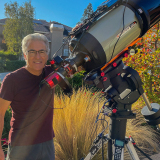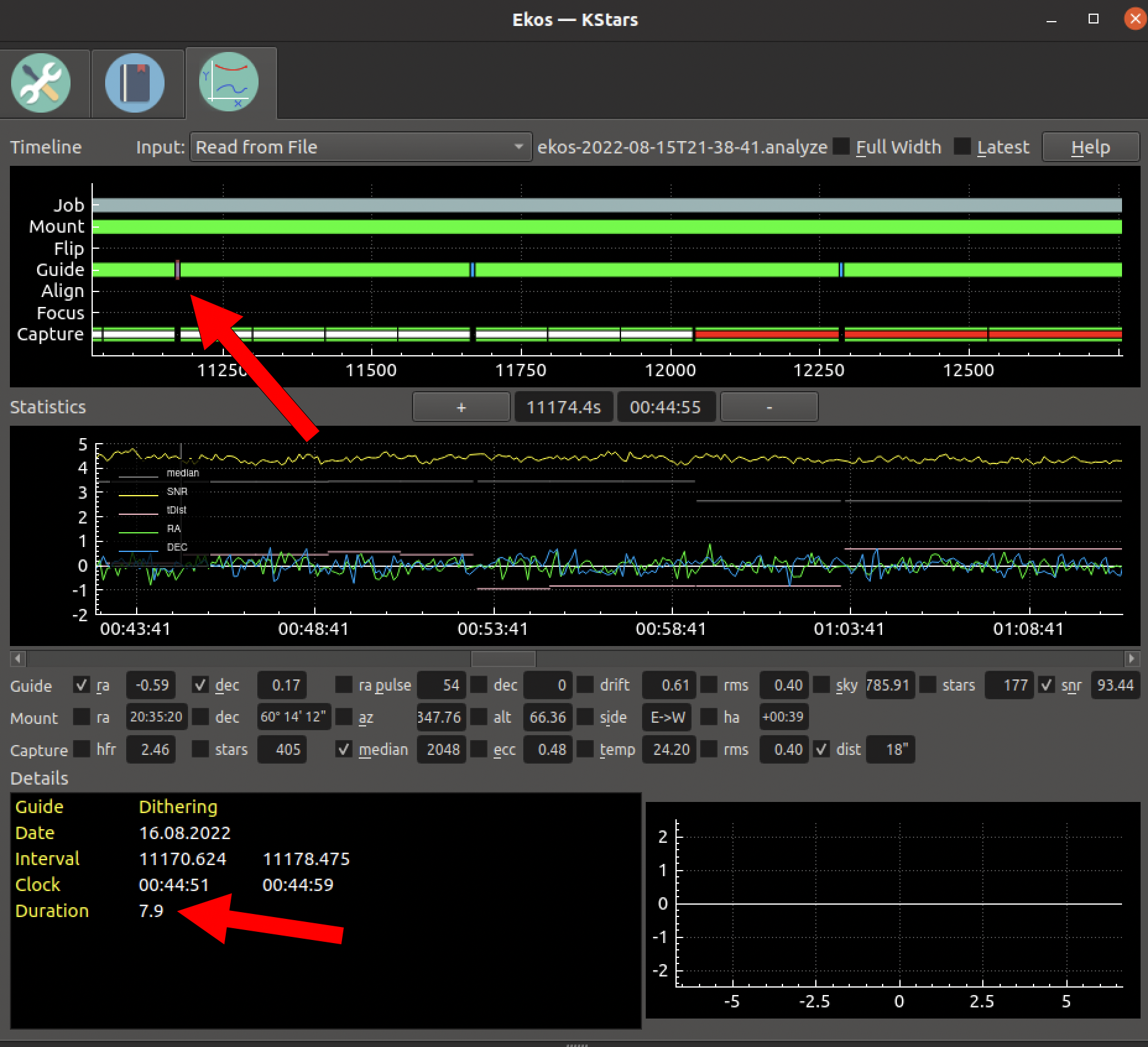×
INDI Library v2.0.7 is Released (01 Apr 2024)
Bi-monthly release with minor bug fixes and improvements
Dithering - Number of pixels vs One Pulse Dither
- Frederick Ruegsegger
-
 Topic Author
Topic Author
- Offline
- Elite Member
-

- Posts: 209
- Thank you received: 29
In the never ending quest for improved image quality and guiding I was wondering if anyone had any data on merits of using the EKOS dithering settings based on number of pixels vs. One Pulse Dither?
Most forum topics on dithering talk in terms of pixels and there's lots of information - it's what I've used historically. I haven't been able to find much information on the EKOS One Pulse Dither alternative (not to be confused with Non-Guide Dither Pulse). The tool tip for the One Pulse Dither selection indicates EKOS sends a random dither pulse and the pixel counts that might be set are ignored. The tool tip indicates that One Pulse Dither is recommended and is faster, which is nice, all other things equal. Aside from speed, why would One Pulse Dithering be recommended by the developers?
Most forum topics on dithering talk in terms of pixels and there's lots of information - it's what I've used historically. I haven't been able to find much information on the EKOS One Pulse Dither alternative (not to be confused with Non-Guide Dither Pulse). The tool tip for the One Pulse Dither selection indicates EKOS sends a random dither pulse and the pixel counts that might be set are ignored. The tool tip indicates that One Pulse Dither is recommended and is faster, which is nice, all other things equal. Aside from speed, why would One Pulse Dithering be recommended by the developers?
1 year 6 months ago
#87403
Please Log in or Create an account to join the conversation.
- Hy Murveit
-

- Away
- Administrator
-

- Posts: 1222
- Thank you received: 565
Replied by Hy Murveit on topic Dithering - Number of pixels vs One Pulse Dither
I implemented one pulse dither. I don't think it should improve image quality (nor degrade it either), but rather just made sense to me from an engineering point-of-view.
The idea was that since we were dithering a random amount, it didn't seem important to make sure the the system actually dithered exactly to the random amount chosen. So, what is does is creates a random "target" dither position (as before), and sends the dithering pulses it thinks will get it there (as before), but instead of sending follow-up pulses to get it as close as possible to the desired target position, it changes the "target" to wherever it wound up after the pulses (as long as there was some movement detected).
Hy
The idea was that since we were dithering a random amount, it didn't seem important to make sure the the system actually dithered exactly to the random amount chosen. So, what is does is creates a random "target" dither position (as before), and sends the dithering pulses it thinks will get it there (as before), but instead of sending follow-up pulses to get it as close as possible to the desired target position, it changes the "target" to wherever it wound up after the pulses (as long as there was some movement detected).
Hy
1 year 6 months ago
#87407
Please Log in or Create an account to join the conversation.
- Frederick Ruegsegger
-
 Topic Author
Topic Author
- Offline
- Elite Member
-

- Posts: 209
- Thank you received: 29
Replied by Frederick Ruegsegger on topic Dithering - Number of pixels vs One Pulse Dither
Hy,
Thank you for your reply AND for all you do for EKOS.
I think my question may be better stated in the following way. When you select the number of pixels to move the guiding square you are choosing a random direction but not a random number of pixels (you will know better if I completely wrong about this). So, if I have fixed pattern noise in my sensor I want to eliminate that is 4 or 8 pixels (for example), I'm intentionally selecting that number of pixels and my expectation is that the number of pixels is not random. So, if the pulse dither is random, how do I know I'm addressing the noise I'm trying to manage?
Thank you for your reply AND for all you do for EKOS.
I think my question may be better stated in the following way. When you select the number of pixels to move the guiding square you are choosing a random direction but not a random number of pixels (you will know better if I completely wrong about this). So, if I have fixed pattern noise in my sensor I want to eliminate that is 4 or 8 pixels (for example), I'm intentionally selecting that number of pixels and my expectation is that the number of pixels is not random. So, if the pulse dither is random, how do I know I'm addressing the noise I'm trying to manage?
1 year 6 months ago
#87409
Please Log in or Create an account to join the conversation.
- Hy Murveit
-

- Away
- Administrator
-

- Posts: 1222
- Thank you received: 565
Replied by Hy Murveit on topic Dithering - Number of pixels vs One Pulse Dither
Frederick,
I stand corrected. I had thought that both the direction and the number of pixels dithered was random, but I just checked the code and you are correct. The number of pixels (with the standard dithering approach) is fixed to the user-supplied option in the guider/dithering menu, though that number of pixels is along a random direction. Therefore, my argument about it not mattering with one-pulse guiding is a weaker one.
In any event, if you wish to keep the dither length fixed, just uncheck one-pulse guiding.
Hy
I stand corrected. I had thought that both the direction and the number of pixels dithered was random, but I just checked the code and you are correct. The number of pixels (with the standard dithering approach) is fixed to the user-supplied option in the guider/dithering menu, though that number of pixels is along a random direction. Therefore, my argument about it not mattering with one-pulse guiding is a weaker one.
In any event, if you wish to keep the dither length fixed, just uncheck one-pulse guiding.
Hy
The following user(s) said Thank You: Peter Sütterlin, Frederick Ruegsegger
1 year 6 months ago
#87411
Please Log in or Create an account to join the conversation.
- Peter Sütterlin
-

- Offline
- Supernova Explorer
-

- Posts: 1009
- Thank you received: 133
Replied by Peter Sütterlin on topic Dithering - Number of pixels vs One Pulse Dither
Oh, that did surprise me, too. I also had thought the dither pixels specify the maximum radius. Does PHD2 do it that way, too?
Anyhow, I use, and absolutely like the OPD option. It has largely reduced my dither times, without further drawbacks. That might of course be because the CEM60EC has no large error when doing the dither, and I typically have at least 40-50 distinct dither positions...
Anyhow, I use, and absolutely like the OPD option. It has largely reduced my dither times, without further drawbacks. That might of course be because the CEM60EC has no large error when doing the dither, and I typically have at least 40-50 distinct dither positions...
1 year 6 months ago
#87432
Please Log in or Create an account to join the conversation.
- Frederick Ruegsegger
-
 Topic Author
Topic Author
- Offline
- Elite Member
-

- Posts: 209
- Thank you received: 29
Replied by Frederick Ruegsegger on topic Dithering - Number of pixels vs One Pulse Dither
I find the OPD option attractive from a time perspective, however it would be good to know what the average dither amount, in pixels, actually is. My current dithering times vary between 25 seconds and 60 seconds using the usual method. Over the course of a night, that adds up! In your use, how has OPD performed in terms of dither time?
1 year 6 months ago
#87439
Please Log in or Create an account to join the conversation.
- Hy Murveit
-

- Away
- Administrator
-

- Posts: 1222
- Thank you received: 565
Replied by Hy Murveit on topic Dithering - Number of pixels vs One Pulse Dither
Just looked at one of my logs and it seems to take me 8-12s for one pulse dithering. I have a reasonably fast Mini-PC running my jobs.
You probably know this, but to check the time, just look at the Analyze tab, set Input to "Read from File" and find for some previous night (or just use the current session), zoom in, and click on the various dithering attempts which look like breaks in the guiding timeline until you're zoomed in enough. Statistics for dithering, including total time taken is printed in the Details window in the lower left. There's nothing to get an average of all your dithering attempts, so best to just click on a bunch of them. You can use the right arrow or left arrow to move the timeline if you're zoomed in.
You can also enable debug logging to file for all the Ekos modules and search for the word dither in the log which will show lots of details.
For scale, the "White" captures below are 120s and the "Red" are 240s long.
You probably know this, but to check the time, just look at the Analyze tab, set Input to "Read from File" and find for some previous night (or just use the current session), zoom in, and click on the various dithering attempts which look like breaks in the guiding timeline until you're zoomed in enough. Statistics for dithering, including total time taken is printed in the Details window in the lower left. There's nothing to get an average of all your dithering attempts, so best to just click on a bunch of them. You can use the right arrow or left arrow to move the timeline if you're zoomed in.
You can also enable debug logging to file for all the Ekos modules and search for the word dither in the log which will show lots of details.
For scale, the "White" captures below are 120s and the "Red" are 240s long.
1 year 6 months ago
#87441
Attachments:
Please Log in or Create an account to join the conversation.
- Frederick Ruegsegger
-
 Topic Author
Topic Author
- Offline
- Elite Member
-

- Posts: 209
- Thank you received: 29
Replied by Frederick Ruegsegger on topic Dithering - Number of pixels vs One Pulse Dither
Thanks Hy! That's where I got my times - so clearly mine are a multiple of yours. So the musical question is, what is the average of the random dithers - that is the missing piece for me.
All the best,
Fred
All the best,
Fred
1 year 6 months ago
#87442
Please Log in or Create an account to join the conversation.
- Bernd Limburg
-

- Offline
- Premium Member
-

- Posts: 145
- Thank you received: 15
Replied by Bernd Limburg on topic Dithering - Number of pixels vs One Pulse Dither
Hi,
does OPD take into account any backlash? If the current dither pulse is going in a "backlashed" direction, it might result in no movement at all. Will OPD check for any minimum movement?
CS, Bernd
does OPD take into account any backlash? If the current dither pulse is going in a "backlashed" direction, it might result in no movement at all. Will OPD check for any minimum movement?
CS, Bernd
1 year 5 months ago
#87710
Please Log in or Create an account to join the conversation.
- Hy Murveit
-

- Away
- Administrator
-

- Posts: 1222
- Thank you received: 565
Replied by Hy Murveit on topic Dithering - Number of pixels vs One Pulse Dither
No. It is literally “one pulse”, or at least one for RA and one for DEC.
1 year 5 months ago
#87718
Please Log in or Create an account to join the conversation.
- Bernd Limburg
-

- Offline
- Premium Member
-

- Posts: 145
- Thank you received: 15
Replied by Bernd Limburg on topic Dithering - Number of pixels vs One Pulse Dither
I see - thanks for the info!
1 year 5 months ago
#87726
Please Log in or Create an account to join the conversation.
Time to create page: 2.987 seconds
© 2003-2022 by INDI Library. All rights reserved.

